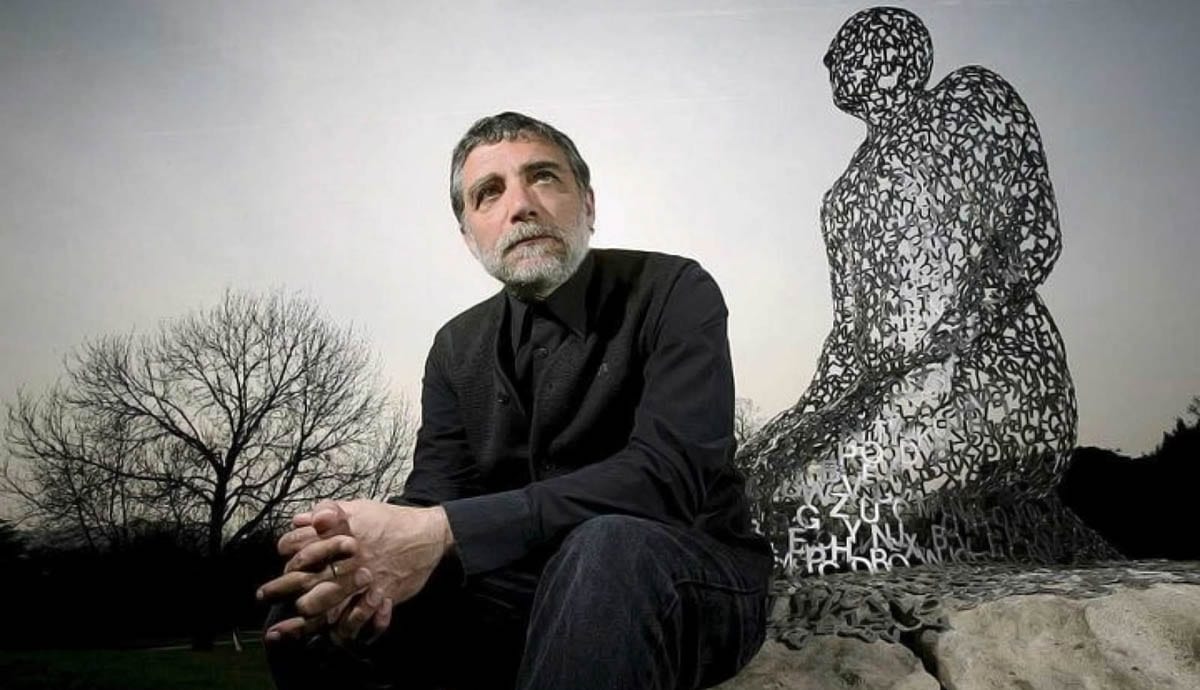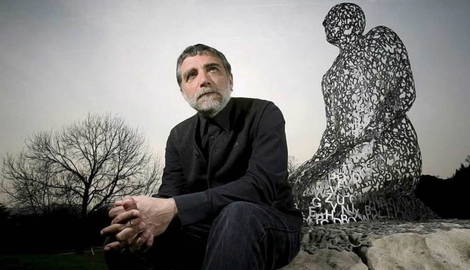
Plensa in front of his Yorkshire Soul, 2010, via Designboom
Jaume Plensa moves amidst dreams and reality. His sculptures and installations redefine the rules of our interaction with art, reclaim the public space, and raise questions of introspection to awake the plethora of information we unconsciously hide within. ‘The wonderful thing about sculpture is the impossibility of describing it’ claims the artist, as he invites us to meet him at the bridge that connects all opposites: the specific and the general, the personal and the public, the human and the soul.
Jaume Plensa: A Visual Poet Who Can’t Float

Contemporary artist Jaume Plensa was born on August 23, 1955, in Barcelona, Spain. Best known for his colossal sculptures of the human figure, his interactive public artwork, and his innovative use of technology, Plensa is among the most internationally recognized Catalonian artists.
‘I may be a son of Barcelona, born beside the sea, but I cannot float!’ confesses the 64-years-old sculptor. When as a child, taken by his mortified mother to swimming lessons, the artist had given up after many unsuccessful attempts. Until one day, while in Jerusalem, his friends took him to the Dead Sea. Suddenly failure vanished, and doubt transformed into a celebration. It wasn’t that Jaume Plensa was incapable of floating; he had just not found the right sea for him.
The sculptor amplifies this personal anecdote as a metaphor for the endless search of the human being for finding one’s place. This poetic conscience is reflected in his works. Most share the quality of the unexpected within the quotidian. A subtle play between reservation and attraction, an ironic ambivalence not strange to the artist who loves to tension the strings between opposites to find new grounds.
A Voice For Humanity

Jaume Plensa uses sculpture as an ideal way to pose questions. Firenze II (1992) is a massive question mark with the word rêve (dream) captured in its front surface. The ponderousness of the iron instantaneously evaporates at the moment we identify the lightness of the word, but almost immediately we are drawn back to noticing its conflicting qualities. The insubstantial world of dreams seems to be seized within a cast of mass production. The commodity of goods that arrived with modernity surrounds and inhabits our daily lives, distracting us from what is essential to the soul. In a time in the art world when taking beauty back to the people can even be considered counterculture, Plensa opts for the subversive finding technical solutions to make dreams tangible as a way to return beauty to the everyday.

For Jaume Plensa, art is what happens in-between. The interaction of the audience is what activates his pieces. The artist often explores themes of memory and globalization concerning the human condition. In Glückauf?, the tinkling sound that the hanging metal letters produce takes another meaning, while a hidden message becomes apparent during the interaction of the public with the piece. A message destined for all humanity: The Universal Declaration of Human Rights adopted by the United Nations in 1948 as a response to the atrocities of World War II. An invitation to engage in our history in order to participate in building a better future, Glückauf? also acts as a reminder of the importance of protecting the freedom of individuals and respecting all human values.

Jaume Plensa enjoys creating public art perhaps more than for museums and galleries. Such projects allow him to bring art to the people by ‘creating situations’ where those who would not commonly engage with art, find themselves becoming part of the artwork.
In 2004 the artist collaborated with the City of Chicago and the Art Institute of Chicago to build two crystal-brick towers as part of one of his most famous installations. Crown Fountain can be interpreted as a self-identification project since it involved the recording of more than 1,000 Chicagoan faces with closed eyes and gestures of blowing of a candle, captured during a period of four years.
Like a conversation between two people, both individuals face each other in the public space of Millennium Park. A type of contemporary gargoyle fountains that spit water through their mouths as a symbol of life. The artist reflects on how life manifests through water caves; mouth and words, womb and birth, eyes and tears to raise the question, what gives life to a city?

Beyond the architecture that composes a cityscape, the essence of a city is its community and its people. With hesitancy from the City that the piece could result as too intellectual and technological, Jaume Plensa opted for removing the surrounding fence to allow the people to interact with the piece. Children led the way as they arrived to play at the reflective pool between the faces, using it as a stage to reclaim the public space in an almost ancient way by reviving the Classical ideal of the agora or plaza as a place for the people.
In this way, Crown Fountain acts as an icon of Chicago where faces of all ages, backgrounds and cultures become amplified through pulsating light. Water and sound echo together with the voices of new generations that fill the empty space with play, discovery and interaction.
The Poetry Of Silence

As a counterpoint, pieces such as Nuria and Irma speak with the power of silence. Over the last decade, with the help of 3D-technology, Jaume Plensa has created a series of female portraits ranging in materials from steel and alabaster to wood and bronze. Despite the large scale, his creations evoke intimacy and seek to establish a connection with the audience.
Acting as shelters of daydreaming, Nuria and Irma depart uninterested from their surrounding landscape, allowing us to see inside and through their heads as if the only purpose of the surface was to reveal the interior.
Plensa uses juxtaposed elements. Nature and technology interblend to form a new identity engaged in silent dialogue and light. With eyes closed as a symbol of introspection, these pieces speak of tenderness amid chaos and aim to remind us about the importance of finding a balance amid the haste and noise.

The Heart of Trees is an example of Jaume Plensa’s extraordinary physical poetry and dexterity to play with indoor and outdoor spaces. Seven bronze self-portraits of a seated Plensa hug natural trees that will eventually overgrow the arms that embrace them. By combining these contrasting materials, the artist explores the central concept of the cycle of life paired with the relationship of the body and soul. The tree, just as the soul, may grow limitless until breaking free from the corporeal figure that contains it.

The artist often refers to ‘the potential poetry of diversity’ and has described the human body as a fantastic container of dreams. Inspired by diverse ethnicities and races, often immigrants, Jaume Plensa’s oneiric public sculptures of girls with closed eyes as Awilda stand for the artist’s utopian vision of a world without boundaries, where poetry is a universal language with the capacity to bring humanity together.

Possibilities is one of the figures that Jaume Plensa calls ‘nomads’ due to their pilgrimage presence around the world. Made entirely of steel letters from a combination of alphabets (Hebrew, Latin, Greek, Chinese, Arabic, Russian, Japanese, Cyrillic, and Hindu) the sculpture offers us a new place to inhabit with a new language to read. Acting as an extra skin of words, Possibilities explores the power of letters, understanding them as biological cells that need others to communicate and create words, invent languages, and shape cultures. The use of the written word in the human anatomy denotes how intertwined poetry is with our bodies. If ‘each human being is a place’ as Plensa claims, then that is a place to invite others to come in.

Commissioned by The City of Montréal’s Public Art Bureau on occasion for their 375th anniversary, Jaume Plensa created Source, a monumental public artwork installed at the entrance to the downtown area of the ever-growing metropolis. Plensa envisioned the piece as a way to celebrate the city’s history, growth and diversity. Even the title commemorates the origins and roots of Montréal, as the word source is shared by both languages, French and English. Composed by elements from multiple alphabets, Source stands as a symbol for the rich and inclusive culture of the city. A metaphor for language as a bridge that connects people across different eras and backgrounds. In Plensa’s words, ‘Sometimes you must breathe a certain soul in a street or an urban context to push people to be together.’ An almost breathing soul that dominates the urban landscape as a gathering place for its citizens and visitors to dream, Source intends to connect the vibrations of humans with their environments.
Echoes Of The Self

When Jaume Plensa was a child he used to hide within his father’s piano. He recalls the feeling of becoming one with music, the vibration and sound filling the inner space, the mind and soul. The theory of echoing energy waves is explored in Jerusalem as an invitation to play and beat the gongs, to feel and vibrate with the sound. The reflective qualities of bronze interplay with the projected light and dark ambiance of the place enhancing mystery.

Conceptual dualities and symbols are elements that Jaume Plensa largely implements in his work. Rumor is inspired by William Blake’s verses of The Marriage of Heaven and Hell and the concept that enlightenment comes from darkness. The line ‘The cistern contains, the fountain overflows’ is engraved on the bronze plate. The single drop of water that falls on the suspended plate seems to complete Blake’s line ‘One thought, fills immensity.’ It materializes the sound of water with every drop that drips on it. The repetitive sound becomes music filling the entire space. Water that someday will find its way back to the sea. That same sea in which we all seek to float on our own.
Jaume Plensa’s World As An Oyster

Jaume Plensa is a reserved man, a deep thinker that cultivates intuition and defends integrity. A curious object that depicts this is Self-Portrait. A half-way open oyster suggests its willingness to discover and be discovered. We find ourselves, once again, under the question mark, an ever-present symbol of Plensa attached to the top surface of the mollusk. A reminder that no dream can exist without desire.

Jaume Plensa often describes some of his pieces as houses. Ogijima’s Soul is the symbol of coming home to many on that Japanese island. A pavilion gets crowded every evening with the announced arrival by boat of all villagers to a roof full of world alphabets. The reflection completed by light in the water, although not tangible, is just as real and important as the architectural piece. Affected by sounds, vibrations, and ultimately our presence, the water projects the image that completes a symmetrical form: that of an oyster. A homage to the sea as a bridge that connects all cultures. A full-circled event of the everyday. A return to home.









